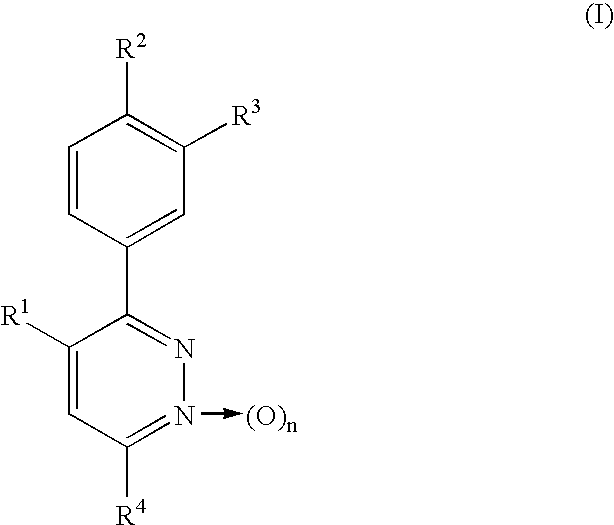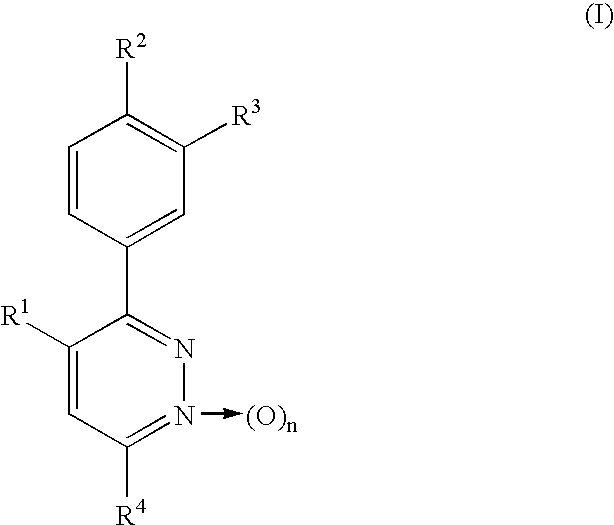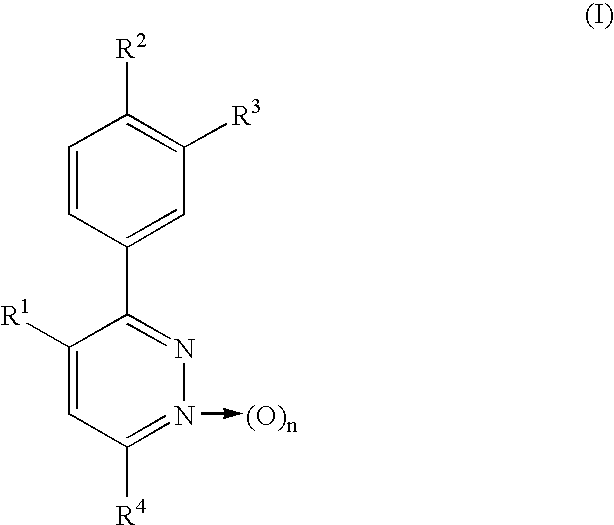Phenylpyridazine compounds and medicines containing the same
- Summary
- Abstract
- Description
- Claims
- Application Information
AI Technical Summary
Benefits of technology
Problems solved by technology
Method used
Image
Examples
example 1
Preparation of 3,4-bis(4-methoxyphenyl)-6-phenylpyridazine
3,4-Bis(4-methoxyphenyl)-6-chloropyridazine [Eur. J. Med. Chem.-Chimica Therapeutica, 14, 53-60 (1979)] (309.3 mg, 0.95 mmol) was dissolved in benzene (2 ml). Tetrakis(triphenylphosphine)palladium [Pd(Ph.sub.3 P).sub.4 ] (90.6 mg, 0.08 mmol) and phenylmagnesium bromide (1.0 M tetrahydrofuran solution) (1.5 ml) were then added successively, followed by stirring at 60.degree. C. for 75 minutes. After water-methylene chloride was added to the reaction mixture, the mixture was extracted with methylene chloride and the organic layer was dried over anhydrous sodium sulfate. The solvent was distilled off and the residue was then separated and purified by chromatography on a silica gel column [silica gel (40 g), hexane / ethyl acetate (2 / 1)], whereby the title compound was obtained as a pale yellow amorphous solid (129 mg, 36.9%)
.sup.1 H-NMR (CDCl.sub.3) .delta.: 3.83(3H,s), 3.84(3H,s), 6.86(2H,d,J=9.04 Hz), 6.90(2H,d,J=9.04 Hz), 7.22(...
example 2
Preparation of 3,4-bis(4-methoxyphenyl)-6-(2,4-difluorophenylthio)pyridazine
3,4-Bis(4-methoxyphenyl)-6-chloropyridazine (440 mg, 1.35 mmol) was dissolved in N,N-dimethylformamide (5 ml). Potassium carbonate (400 mg, 2.90 mmol) and 2,4-difluorothiophenol (300 mg, 2.05 mmol) were then added successively, followed by stirring at 80.degree. C. for 7 hours. The reaction mixture was concentrated under reduced pressure, the residue was extracted with chloroform, and the organic layer was dried over anhydrous sodium sulfate. The solvent was distilled off, the residue was separated and purified by preparative thin-layer chromatography on a silica gel [developing solvent: hexane / ethyl acetate (8 / 1)], and the resulting crystals were recrystallized from chloroform-diethyl ether-hexane, whereby colorless needles were obtained (219.7 mg, 37.4%). Melting point: 112.0-113.0.degree. C.
.sup.1 H-NMR (CDCl.sub.3) .delta.: 3.80(3H,s), 3.81(3H,s), 6.80(2H,d,J=8.79 Hz), 6.83(2H,d,J=8.79 Hz), 6.95-7.02(3H,...
example 3
Preparation of 3,4-bis(4-methoxyphenyl)-6-(phenoxy)pyridazine
In a similar manner as in Example 2, 3,4-bis(4-methoxyphenyl)-6-chloropyridazine (160 mg, 0.490 mmol) and phenol were reacted as starting materials at 120.degree. C. for 22 hours and post-treatment was then conducted, whereby the title compound was obtained as colorless needles (133.1 mg, 70.7%). Melting point: 198.8-199.5.degree. C. (ethyl acetate-hexane).
.sup.1 H-NMR (CDCl.sub.3) .delta.: 3.81(3H,s), 3.83(3H,s), 6.81(2H,d,J=9.04 Hz), 6.85(2H,d J=8.79 Hz), 7.09(1H,s), 7.15(2H,d,J=8.79 Hz), 7.21-7.31(3H,m), 7.34(2H,d,J=9.04 Hz), 7.35-7.46(2H,m).
IR (KBr) cm.sup.-1 : 1608,1512,1489,1419,1397,1251,1216,1174.
PUM
 Login to View More
Login to View More Abstract
Description
Claims
Application Information
 Login to View More
Login to View More - R&D
- Intellectual Property
- Life Sciences
- Materials
- Tech Scout
- Unparalleled Data Quality
- Higher Quality Content
- 60% Fewer Hallucinations
Browse by: Latest US Patents, China's latest patents, Technical Efficacy Thesaurus, Application Domain, Technology Topic, Popular Technical Reports.
© 2025 PatSnap. All rights reserved.Legal|Privacy policy|Modern Slavery Act Transparency Statement|Sitemap|About US| Contact US: help@patsnap.com



